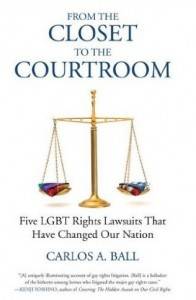Most of us ― gay or straight ― could name at least a few of the groundbreaking events in American history that have affected LGBT civil rights:
- The Stonewall riots in 1969
- The defeat of California’s Proposition 6 ballot measure in 1978
- The AIDS crisis in the ‘80s, and the public’s response (or lack thereof)
- The 1987 March on Washington for Lesbian and Gay Rights
- The ACT-UP protests throughout the ‘90s
- The nation’s response to the torture and murder of Matthew Shepard
 But what far too many of us don’t know is that, while these political and social protests were making headlines, five equally important lawsuits were being argued in our courts (a few with little, if any, media attention), lawsuits that remade the “political, social, and moral landscape” of the nation (1). Carlos A. Ball’s From the Closet to the Courtroom tells the story of these cases.
But what far too many of us don’t know is that, while these political and social protests were making headlines, five equally important lawsuits were being argued in our courts (a few with little, if any, media attention), lawsuits that remade the “political, social, and moral landscape” of the nation (1). Carlos A. Ball’s From the Closet to the Courtroom tells the story of these cases.
“Tells the story” is an appropriate description, for the author has the ability to explain intricate, complicated legislation and constitutional law in a way that reads like a suspenseful novel, and yet he never lessens the importance of the cases, or lets us forget that the plaintiffs behind the lawsuits are incredibly brave human beings.
The five landmark ― and successful ― trials discussed in this book are Supreme Court cases that readers might have heard of, but know little about:
• Braschi v. Stahl Associates (1989)
Miquel Braschi had lived with his partner, Leslie Blanchard, in a rent controlled apartment for 15 years. When Blanchard died, Stahl Associates threatened to evict Braschi, because he and Blanchard were not considered to be a family, and thus, Braschi was not protected by rent control law.
• Baehr v. Lewin (1993)
In this, the first same-sex marriage case, it was argued that differential treatment of same-sex couples was “constitutionally suspect because it constituted a form of sex discrimination” (194).
• Nabozny v. Podlesny (1996)
Throughout high school, Jamie Nabozny was relentlessly and violently bullied and humiliated by some of his classmates. This was repeatedly ignored by the school’s officials, and no amount of pleading by Jamie or his parents helped. After he graduated, Jamie decided to sue.
• Romer v. Evans (1996)
In 1992, Colorado passed Amendment 2, which made it “illegal to protect sexual minorities against discrimination based on their sexual orientation.” This amendment, in effect, forced gay people back into the closet. The plaintiffs (many of whom were community leaders in Colorado) immediately filed a lawsuit to stop the enforcement of Amendment 2, and won what was at that time “the greatest judicial victory in the history of the American LGBT rights movement” (138).
• Lawrence v. Texas (2003)
John Lawrence and Tyron Garner were abducted in Lawrence’s apartment and arrested for sodomy, which violated Texas’ Homosexual Conduct Law. After their arrest, they were held in a cell with other male prisoners for 24 hours, then arraigned and released without bail. They took their case all the way to the Supreme Court and won the right of “individual dignity and autonomy” for all same sex couples (3).
Each chapter is divided into four sections:
- “The Facts,” in which Ball provides personal background information about the people filing the lawsuits, oftentimes recounting, in touching detail, the torment and subsequent fear and embarrassment that resulted from the discrimination they experienced.
- “The Lawyer,” which discusses the attorneys in equal detail. Ball provides their background, concerns, and strategies, with the result that we feel as if we know them as intimately as we do the men and women who bravely filed the lawsuits.
- “The Law” section is where Ball explains the reasoning behind the anti-gay rights laws, and gives them fair examination, while simultaneously explaining why they could not hold up under constitutional scrutiny.
- “The Impact.” Here is where Ball includes the many reactions and responses following the rulings, and the significant influence each of them had (and still have) on future civil rights cases involving LGBTQ people.
I already knew quite a bit about all of these cases before I read Ball’s book. But included in its pages are juicy details of which even the most staunch gay rights activist might not be aware. For example, I had no idea that following the success of Baehr v. Lewin in Hawaii, a rally called “Campaign to Protect Marriage” was organized by the Christian Coalition, Focus on the Family, the Traditional Values Coalition, and the Family Research Council. This event, held in Des Moines in 1996, was attended by presidential candidate Pat Buchanan, “while other G.O.P candidates … sent letters of support,” including Republican nominee Robert Dole (188). It was this rally that encouraged neo-cons to write and campaign for the Defense of Marriage Act.
Another interesting fact: when Lawrence v. Texas was being argued before the Supreme Court, out of the 35 questions put forward by the Justices that day, 23 were asked by Justice Scalia. I was also unaware that Scalia believes that the state has a right to limit the intimacy choices of all couples, be they gay or straight or married or not (228). This book is filled with fascinating details like this, but it also does not shy away from scholarship. Each case is documented thoroughly, and the Notes section is an invaluable bibliography of related court cases and topical books.
From the Closet to the Courtroom is unhesitatingly recommended for anyone, gay or straight, who is interested in civil rights movements in this country. It is also recommended for law students planning to practice civil rights law.
Finally, it is recommended for all LGBTQ people. Ball states that “[c]ivil rights struggles in this country usually consist of moments of heartening progress followed by instances of discouraging setbacks” (191). Currently, no one knows this more than LGBTQ people. We must learn our history, for that will ensure a more equal and safe future. Awareness of the five Supreme Court cases in this text will remind us that we no longer have to “play defense” (148). The law is on our side. We have precedence. We shouldn’t forget that.
Publication information:
 Ball, Carlos A. From the Closet to the Courtroom: Five LGBT Rights Lawsuits That Have Changed Our Nation. Queer Action/Queer Ideas Ser. Boston: Beacon Press, 2010.
Ball, Carlos A. From the Closet to the Courtroom: Five LGBT Rights Lawsuits That Have Changed Our Nation. Queer Action/Queer Ideas Ser. Boston: Beacon Press, 2010.
Carlos A. Ball taught at the University of Illinois College of Law for eight years. He is currently Professor of Law and Judge Frederick Lacey Scholar at Rutgers School of Law in Newark.








